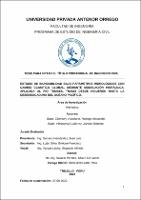Mostrar el registro sencillo del ítem
Estudio de inundabilidad bajo parámetros hidrológicos con cambio climático global, mediante modelación hidráulica, aplicada al Río Tumbes, Tramo desde Higuerón hasta la desembocadura del Océano Pacífico
| dc.contributor.advisor | Salazar Perales, Álvaro Fernando | |
| dc.contributor.author | Chávarry Victoriano, Rodrigo Alexander | |
| dc.contributor.author | Villanueva Gutiérrez, Junnior Roberto | |
| dc.creator | Chávarry Victoriano, Rodrigo Alexander | |
| dc.date.accessioned | 2022-12-27T16:30:02Z | |
| dc.date.available | 2022-12-27T16:30:02Z | |
| dc.date.issued | 2022 | |
| dc.identifier.uri | https://hdl.handle.net/20.500.12759/9904 | |
| dc.description.abstract | La presente investigación, nos muestra el uso de herramientas computacionales como la modelación numérica aplicada a la hidrología e hidráulica. Para una mayor representación en los procesos físicos de la cuenca hidrológica del rio tumbes y su movimiento histórico de su flujo en su cauce principal respectivamente. En la cual estos procesos físicos, han sido afectado durante el tiempo por el cambio climático, perjudicando la temporada de lluvias con un aumento significativo. Y es por eso que se implementa modelos climático globales en la hidrología de la cuenca de estudio, con la finalidad de ver su influencia a futuro y realizar una comparación de los diferentes caudales que puedan resultar para una avenida centenaria. La investigación, parte de un tratamiento de las variables meteorológicas que tienen consigo una inhomogeneidad en su registro, y esto se solucionó mediante el paquete de R-Climatol, la cual es un paquete del lenguaje de programación R. Posterior a ello, la construcción de un modelo hidrológico semidistribuido SWAT, donde se realizó una calibración estricta para poder tener una mayor representación en los procesos hidrológicos y tener proyecciones futuras confiables. Concluyendo en hidrogramas de entradas para un modelo hidrodinámico bidimensional como lo es “Hec-ras”, donde se realizó una validacion con mediciones de campo que se desarrolló en diferentes periodos temporales. Culminando en mapas de inundaciones donde se representa las velocidades en respuesta de una avenida centenaria y sus tirantes (o conocido como calado), además de elaboración de mapas de para la gestión de inundación fluvial por la normatividad de CENEPRED (Centro Nacional de Estimación, Prevención y Reducción de Riesgos de Desastres). Las cuales son la peligrosidad, vulnerabilidad y riesgo en el área de la cuenca de Tumbes, partiendo de la estación hidrométrica Higuerón hasta la desembocadura del Océano Pacifico. | es_PE |
| dc.description.abstract | This research shows the use of computational tools such as numerical modeling applied to hydrology and hydraulics. For a better representation of the physical processes of the hydrological basin of the Tumbes River and lts historical movement of its flow in its main, channel respectively. In which these physical processes have been affected over time by climate change, damaging the rainy season with a significant increase. That is why global climate models are implemented in the hydrology of the study basin, in order to see its influence in the future and make a comparison of the different flows that may result for a centennial flood. The research starts with a treatment of the meteorological variables that have an inhomogeneity in their registration, and this was solved by means of the R Climatol package, which is a package of the R programming language. Subsequently, the construction of a semi-distributed SWAT hydrological model, where a strict calibration was performed in order to have a better representation of the hydrological processes and to have reliable future projections. Concluding in input hydrographs for a two-dimensional hydrodynamic model such as ““Hec-ras““, where a validation was performed with field measurements that were developed in different times. Culminating in flood maps where the velocities are represented in response to a centennial flood and its depths (or known as draft), in addition to the development of maps for river flood management by the regulations of CENEPRED (National Center for Estimation, Prevention and Reduction of Disaster Risks). These are the hazard, vulnerability and risk in the area of the Tumbes basin, starting from the Higueron hydrometric station to the mouth of the Pacific Ocean | en_US |
| dc.description.uri | Tesis | es_PE |
| dc.format | application/pdf | es_PE |
| dc.language.iso | spa | es_PE |
| dc.publisher | Universidad Privada Antenor Orrego - UPAO | es_PE |
| dc.relation.ispartofseries | T_CIVIL_2162 | |
| dc.rights | info:eu-repo/semantics/openAccess | es_PE |
| dc.rights.uri | https://creativecommons.org/licenses/by/4.0/ | es_PE |
| dc.source | Universidad Privada Antenor Orrego | es_PE |
| dc.source | Repositorio institucional - UPAO | es_PE |
| dc.subject | Parámetros | es_PE |
| dc.subject | Climático | es_PE |
| dc.title | Estudio de inundabilidad bajo parámetros hidrológicos con cambio climático global, mediante modelación hidráulica, aplicada al Río Tumbes, Tramo desde Higuerón hasta la desembocadura del Océano Pacífico | es_PE |
| dc.type | info:eu-repo/semantics/bachelorThesis | es_PE |
| thesis.degree.grantor | Universidad Privada Antenor Orrego. Facultad de Ingeniería | es_PE |
| thesis.degree.name | Ingeniero Civil | es_PE |
| thesis.degree.discipline | Ingeniería Civil | es_PE |
| dc.subject.ocde | http://purl.org/pe-repo/ocde/ford#2.01.00 | es_PE |
| renati.advisor.orcid | https://orcid.org/0000-0003-3498-7934 | es_PE |
| renati.author.dni | 71466497 | |
| renati.author.dni | 45834528 | |
| renati.advisor.dni | 18216844 | |
| renati.type | http://purl.org/pe-repo/renati/type#tesis | es_PE |
| renati.level | http://purl.org/pe-repo/renati/level#tituloProfesional | es_PE |
| renati.discipline | 732016 | es_PE |
| renati.juror | Serrano Hernández, José Luis | |
| renati.juror | Luján Silva, Enrique Francisco | |
| renati.juror | Vargas López, Segundo Alfredo | |
| dc.publisher.country | PE | es_PE |
Ficheros en el ítem
Este ítem aparece en la(s) siguiente(s) colección(es)
-
Ingeniería Civil [1085]


